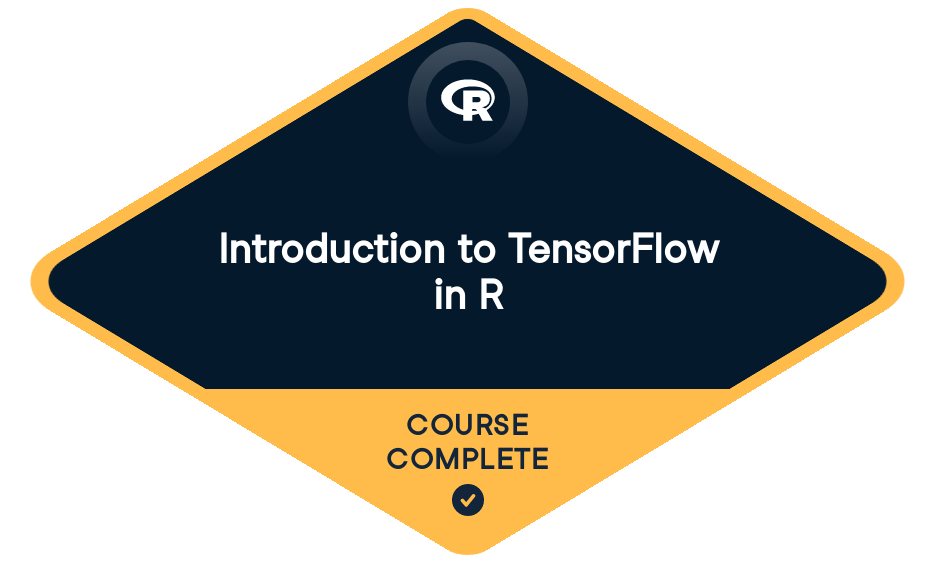
Loved by learners at thousands of companies
Course Description
TensorFlow is a state-of-the-art machine learning framework that specializes in the ability to develop deep learning neural networks. And now, it's available in R! This course will walk you through the basics of using TensorFlow in R. From simple linear regressions to more complex deep learning neural networks (which perform extremely well with BIG datasets) , you'll be introduced to both the basics of TensorFlow and higher-level APIs such as Keras and TFEstimators. We'll put your new-found skills to the test by exploring whether there is a predictable relationship between beer consumption and weather, and find out if we can accurately build a deep neural network to help predict whether a banknote is forged or genuine based on image data.
Training 2 or more people?
Get your team access to the full DataCamp platform, including all the features.- 1
Introducing TensorFlow in R
FreeLet's get you started in TensorFlow! To begin the course, you'll learn the history of the program and will become comfortable using TensorFlow syntax. You'll become versed in TensorFlow constants, placeholders, and Variables and we'll explore some dataflow diagrams using TensorBoard, the TensorFlow visualization tool! This chapter is a great start to get you comfortable with using TensorFlow in R.
What is TensorFlow?50 xpTranslating a dataflow graph50 xpStarting with sessions100 xpTensorFlow syntax, variables, and placeholders50 xpVariables, constants, and placeholders, oh my!50 xpCreate tensors yourself100 xpTensorBoard: visualizing TensorFlow models50 xpCreating a single-step TensorBoard100 xpCreating a multi-step TensorBoard100 xpSessions, constants, and variables in TensorFlow100 xp - 2
Linear Regression using two TensorFlow APIs
Have you ever wondered if we can predict beer consumption in university towns based on weather factors, such as temperature, precipitation, or time of week? Well then do I have a chapter for you!In this chapter, we'll explore linear regression models using both the Core TensorFlow API, as well as the Estimators API (a high-level API with canned models set to speed up the user experience). We'll train and evaluate several models to get you familiar with all the APIs TensorFlow has to offer. And you'll finally be able to answer - do people drink less beer when it's rainy out?
Core API: linear regression50 xpChoosing the correct API50 xpCan you define your x and y data?100 xpWeights, biases, and equations100 xpCore API: linear regression part II50 xpDefining a cost function100 xpLaunching the graph and initializing the variables100 xpCore API: linear regression part III50 xpTraining your model100 xpEvaluating your model100 xpEstimators API: multiple linear regression50 xpDefining feature columns100 xpChoosing a model and input function100 xpTraining and evaluating the model100 xpVisualizing the linear regression100 xp - 3
Deep Learning in TensorFlow: Creating a Deep Neural Network
Let’s dive into some deep learning with TensorFlow! In this chapter, you’ll create a complete end-to-end DNN Classifier with the Keras API, exploring if you can predict online customer buy/don’t buy behaviour. Want to see behind-the-scenes of your classifier? TensorBoard is your answer. You’ll explore scalars and graphs in TensorBoard and take a closer look at the visualizations directly available in R. Finish off the chapter with a glimpse into using a canned DNN Classifier in Estimators. Which is the better API for your model? You decide!
A gentle introduction to neural networks50 xpCalculating an output50 xpCreate a deep neural network model with Keras API50 xpDefining your arguments100 xpDefining and compiling your model100 xpFitting your model100 xpEvaluate, predict and visualize your model50 xpFind the accuracy of your model100 xpPredict the future!100 xpExploring a DNN classifier in TensorBoard100 xpCreate a DNN using the Estimators API50 xpGo with the (work)flow100 xpDNN classifier training using Estimators100 xpDNN classifier using Keras API100 xp - 4
Deep learning in TensorFlow: increasing model accuracy
Now that you've successfully created your first DNN models using TensorFlow in R, it's time to branch out and look at some ways to increase the accuracy of your models. In this chapter, you'll explore a few regularization techniques, including incorporating a Ridge Regression into a Keras model and adding a Dropout technique to an Estimators canned DNN. Finally, we'll wrap up this course by summarizing all the concepts you've learned, and give you some research ideas for you to try on your own!
L2 Regularization Technique using Keras50 xpDefining the regularizer100 xpCompiling and fitting the model100 xpEvaluating the L2 regularization model100 xpDropout technique using TFEstimators50 xpDefining the feature columns and input function100 xpDefining the dropout clause100 xpEvaluating the dropout model100 xpHyperparameter tuning with tfruns50 xpHyperparameter tuning for a DNN model100 xpMultiple hyperparameter tuning100 xpSo long and thanks for all the fish50 xp
Training 2 or more people?
Get your team access to the full DataCamp platform, including all the features.collaborators


prerequisites
Machine Learning with caret in RJoin over 17 million learners and start Introduction to TensorFlow in R today!
Create Your Free Account
or
By continuing, you accept our Terms of Use, our Privacy Policy and that your data is stored in the USA.